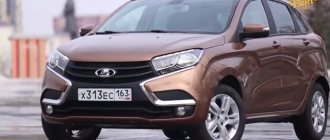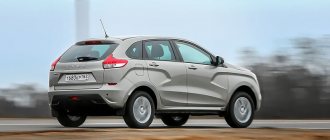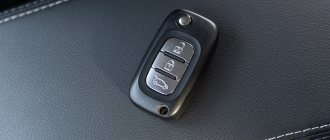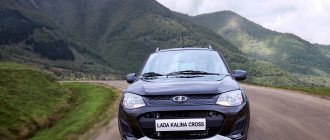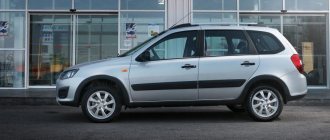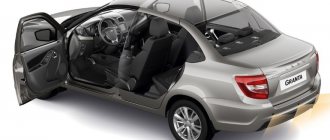— What is the maximum speed? For what? Most journalists on the Almaty-Khorgos highway were interested in the maximum speed. Without consequences, one daredevil managed to reach 191 km/h using the Android app, with the factory setting being 180 km/h. A day earlier, at a presentation in Almaty, VAZ tried to hit on more significant points for the audience of the Lada brand.
Our measurements showed the best result in acceleration from 0 to 100 km/h in 11.76 seconds. The factory figure is 10.9 seconds. There were two people in the car. Gasoline in the tank is AI-95. The plant also allows the use of 92. A total of eight attempts were made on one section of the road
The Russian manufacturer is proud of its performance in foreign markets: Kazakhstan +69% (9,629), Belarus +208% (7,179), Uzbekistan +379% (1,782 cars). This is a dynamic that reflects customer interest in the brand over the nine months of this year compared to the same period in 2017. Lada accounts for 23.1% of the entire market in our country.
The XRAY hatchback, declared by AVTOVAZ as a crossover, launched in 2016. Interest in the model is fading, and in order to maintain sales, it is necessary to create a Cross version, and at the same time introduce the world to the new philosophy of the brand. Four postulates should determine the “Russian carmaker”:
- Memorable and bright design.
- Ease of use on Russian (read: Kazakh) roads.
- Good value for money.
- Availability of modern comfortable options.
1 / 4
The dimensions are modest compared to other B0s. In short, only the Renault Sandero Stepway is narrower and lower
The dimensions are modest compared to other B0s. In short, only the Renault Sandero Stepway is narrower and lower
The dimensions are modest compared to other B0s. In short, only the Renault Sandero Stepway is narrower and lower
The dimensions are modest compared to other B0s. In short, only the Renault Sandero Stepway is narrower and lower
1 / 4
Will the market react to this Cross? I was extremely surprised that the share of Cross versions among Vesta station wagon models is 59%. You understand? The Cross console really rocks. People vote for the raised versions with a body kit all around. But XRAY Cross turned out even cooler, and this is not only the manufacturer’s belief.
They did a good job installing the body kit. There are clips, a 3M adhesive base and heat treatment before installation - heating up to 40 degrees, and the panels take shape better. Don't pull, it holds firmly
We begin to bend our fingers and those of our friends. So, changes in the Cross version in relation to “just XRAY”: increased ground clearance to 215 versus 203 mm, increased suspension travel to 203 versus 176 mm, original front subframe and suspension, rear disc brakes, new bumpers with increased approach and departure angles, plastic body kit, fog lights with cornering lights, aluminum roof rails, electronic differential lock...
The breadth of changes is significant, the processing here is much deeper than in Vesta Cross. The suspension kinematics have been changed, new springs and shock absorbers have been changed; the latter, for example, have changed suppliers - from the Polish Tenneco to the original Russian SAAZ.
The number of changes makes Cross a separate model not only for marketing reasons
According to rumors, when the guys from parent Renault appreciated the handling of the XRAY Cross, they began to look at the VAZ drivers wryly. Perhaps this was the very moment of manifestation of French envy.
We have a little more than 500 km ahead: a good asphalt concrete road from Almaty to Khorgos, a gravel approach to Charyn and a serpentine road to the “Forest Fairy Tale” at an altitude of 1,600 meters above sea level. On the autobahn, I can immediately summarize: the main problem is acoustic noise. You can talk for a long time about a new suspension, silent tires, but if you constantly hear how numerous residents of the engine compartment want to communicate with you, this is not entirely good.
The engine after three thousand also produces not the most pleasant accompaniment. And 3,000 comes already at a permitted speed of 105 km/h. And then I started having “phantom pains” - I switched eight times to the non-existent sixth gear in the JR5 gearbox and received a sound signal - like, brother, be careful, it’s in reverse. And I switched because the fuel was running out (highway - 110 km/h, 7.5 l) and because the sound of the engine was unpleasant. And here miracles do not happen - no six-speed gearbox will appear on this car in the foreseeable future.
On the speedometer - 110, 3,000 revolutions on the tachometer and consumption - 7.5 liters of the 95th. This is the price to pay for the lack of a sixth gear in a manual transmission.
Speed 115–120 km/h. It starts to blow a little from the top of the front window frames. We checked that all the windows were closed. They immediately noticed that they did not find a single power window button with auto mode. But we have climate control, and heating of everything, and standard navigation... By the way, about the last one: we hope that the update will still come, because the system is not loaded with the latest maps of Kazakhstan, they are from 2016.
The interior came to life thanks to amber colored inserts. This is especially true when the body is in a similar color scheme. “Amber” in the technical data sheet sounds like “golden-ochre”, but this is not the problem with the corporate color. The color is quite complex, and you will have to struggle with this after the first bumper collisions
The iron runs great, the car is pleasant to drive, despite the stepwise operation of the electric power steering. At zero it’s empty, when turning it’s thick. The brakes are best to look for, especially since they are all disc brakes. When needed, dynamically; when not needed, in traffic jams you dose it surgically, without straining the muscles of your right calf.
There are no questions about mirrors. Shape, overview - ergonomic. The adjustment is located on the left under the steering column. Let’s remember the new location under the handbrake and calm down...
I can't say that I like the seats. They are amorphous. There is no lumbar support adjustment. When this adjustment is expensive to establish, then you need to find the golden mean by default. She’s not here - her back is like a wheel on the road. The airbags are a bit short for both the driver and the front passenger.
I feel comfortable on the steering wheel, reach adjustment was necessary, and it appeared. In many ways, by the way, thanks to the installation of the EUR, it is more compact. The left foot is conveniently “parked” on the rest area. I activate cruise control in adjustment increments of 1 km/h.
1 / 4
1 / 4
The front passenger complains: his seat lift lever is not working. Broken? No, there is no elevator here, the lever performs the function of... folding the backrest! Those who do home renovations themselves can accommodate construction panels up to 2.7 m. The main thing is not to scratch the front panel. There is a convenient drawer under the seat cushion.
On the back seat, my 175 cm height fits perfectly on its own. For your feet it’s just carte blanche, even in felt boots or skates. There is no central armrest, but there are pockets in the backs of the front seats, and at the end of the tunnel there are buttons for heating the sofa cushion and a USB charging port.
1 / 8
There's an armrest here. True, even a half-liter bottle will not fit vertically into the pencil case. And if it is in the “working position”, it is very difficult to insert the hand and latch the seat belt. Here for ergonomics - a deuce
There's an armrest here. True, even a half-liter bottle will not fit vertically into the pencil case. And if it is in the “working position”, it is very difficult to insert the hand and latch the seat belt. Here for ergonomics - a deuce
There's an armrest here. True, even a half-liter bottle will not fit vertically into the pencil case. And if it is in the “working position”, it is very difficult to insert the hand and latch the seat belt. Here for ergonomics - a deuce
There's an armrest here. True, even a half-liter bottle will not fit vertically into the pencil case. And if it is in the “working position”, it is very difficult to insert the hand and latch the seat belt. Here for ergonomics - a deuce
There's an armrest here. True, even a half-liter bottle will not fit vertically into the pencil case. And if it is in the “working position”, it is very difficult to insert the hand and latch the seat belt. Here for ergonomics - a deuce
There's an armrest here. True, even a half-liter bottle will not fit vertically into the pencil case. And if it is in the “working position”, it is very difficult to insert the hand and latch the seat belt. Here for ergonomics - a deuce
There's an armrest here. True, even a half-liter bottle will not fit vertically into the pencil case. And if it is in the “working position”, it is very difficult to insert the hand and latch the seat belt. Here for ergonomics - a deuce
There's an armrest here. True, even a half-liter bottle will not fit vertically into the pencil case. And if it is in the “working position”, it is very difficult to insert the hand and latch the seat belt. Here for ergonomics - a deuce
1 / 8
The car is well packed. For Lada, of course. We could list the latest equipment for a long time, but let’s not bog it down, look at the presentation slide. Lada burns, doesn't it? This is similar to the maneuver of Korean manufacturers ten years ago - many options for the cost of the competitor’s “base”.
Before the primer I stop at the inspection hole. There's a fancy split exhaust pipe (French manufacturer Faurecia), a lot of potentially "blooming" underbody elements, and what excites us the most are the sills. The plastic engine protection can be removed and a steel one can be ordered, but there is no particular point - the subframe is installed below the crankcase. In general, the bottom profile allows for all-wheel drive. In the evening, VAZ employees repeatedly talked about the “theoretical possibility of installing CVT and all-wheel drive.” But the reality is only front-wheel drive today and an AMT robot for the foreseeable future.
1 / 7
A lightning-fast answer to the question: what if I put springs and shock absorbers from Cross on my XRAY? No, it won’t get up, and even if it does, it will go crooked. The suspension kinematics are different here
A lightning-fast answer to the question: what if I put springs and shock absorbers from Cross on my XRAY? No, it won’t get up, and even if it does, it will go crooked. The suspension kinematics are different here
A lightning-fast answer to the question: what if I put springs and shock absorbers from Cross on my XRAY? No, it won’t get up, and even if it does, it will go crooked. The suspension kinematics are different here
A lightning-fast answer to the question: what if I put springs and shock absorbers from Cross on my XRAY? No, it won’t get up, and even if it does, it will go crooked. The suspension kinematics are different here
A lightning-fast answer to the question: what if I put springs and shock absorbers from Cross on my XRAY? No, it won’t get up, and even if it does, it will go crooked. The suspension kinematics are different here
A lightning-fast answer to the question: what if I put springs and shock absorbers from Cross on my XRAY? No, it won’t get up, and even if it does, it will go crooked. The suspension kinematics are different here
A lightning-fast answer to the question: what if I put springs and shock absorbers from Cross on my XRAY? No, it won’t get up, and even if it does, it will go crooked. The suspension kinematics are different here
1 / 7
We drove off the asphalt, and let’s twist and turn the Ladovsky terrain assistant. I won’t say that the help from electronics is effective. Now, if we were driving automatically, then yes. And on the mechanics, your work with the gas and clutch is what decides. ESC off mode - that's enough for me. Who drives Ladas? People who will “crawl where the crook stops.” Therefore, it seems to us that Lada Ride Select is a fashionable feature, but it is unlikely to be 100 or even 70% in demand. In simple configurations the puck will be removed. And if you noticed, the seat and windshield heating unit is gaping with one plug. This is where the ESC deactivation button will most likely be located in the initial configurations.
Lada Ride Select has five modes. The main one is optimal settings for driving on public roads. ESC - disables the exchange rate control system (up to 58 km/h, then ESC is automatically activated). Snow/Mud - The electronic differential lock and ABS are tuned to perform effectively on slippery roads and in snow. Sand - for movement on soft and loose soils without digging. Sport - minimum intervention from security systems, sharper accelerator pedal
Cross flies on gravel road at the stage of the Charyn rally. By the way, we are rushing along almost the same routes. 80, 90, 100, 110 km/h - and we get only one breakdown during the distance. This is where you forgive the car for all previous flaws. The suspension handles bumps so effectively it's as if red ARB kits were installed.
Here I thank the engineers who used fender liners made of pile material rather than plastic - the stones do not drum. The only limitation is single-wheel drive; with all-wheel drive, the Lada would fly even faster. The suspension absorbs very terrible gullies. The wheels were lifted off the ground twice. And everything is perceived as in a video game - virtually. And there is enough ground clearance to reach places where it would be better to crawl on almost any crossover.
Our measurements showed that the lowest point—the body cross member—produced only 174 mm. There was no one in the car. There is already 24 cm under the front bumper. There is no curb stone on the planet that will scratch the plastic of the Cross, but if you are planning to run over it, be careful not to hang on your belly
In the parking lot near the canyon I “change my shoes.” Never, you hear, would I never drive my car like that! Look at the rims. It's like a knife to the heart. The Lada handles gravel at a completely abnormal speed, but the paintwork on the 17-piece alloy wheels does not support this. This is largely due to the low-profile tires - 215/50 R17, and this is some kind of non-crossover size.
1 / 3
XRAY Cross drives on gravel roads as quickly as it takes chips on beautiful rims
XRAY Cross drives on gravel roads as quickly as it takes chips on beautiful rims
XRAY Cross drives on gravel roads as quickly as it takes chips on beautiful rims
1 / 3
VAZ workers say that stability was important, that’s why it is so wide. The high profile could affect the contact of the front wheels when turning the steering wheel with the fender liners - that is why the profile is 50. Moreover, the Continental CrossContact LX2 tires in their latest update were prepared according to a recipe specifically for this model. Do you believe it? And we don't. Yes, it is normal to upgrade your current tire model in stages. And in this case, the threshold of acoustic noise emitted by the tire was reduced. But for this compound to be “cooked” specifically for the far from most popular AVTOVAZ model...
I climb into the trunk, there is a quite convenient second floor. Next is the underground with the spare wheel. At the underground presentation it was full-size, because there were quite a few side cuts...
1 / 4
Everything in the luggage compartment is logical and not embarrassing in front of competitors. Below we have made a comparison table, including the luggage compartment volume of competitors
Everything in the luggage compartment is logical and not embarrassing in front of competitors. Below we have made a comparison table, including the luggage compartment volume of competitors
Everything in the luggage compartment is logical and not embarrassing in front of competitors. Below we have made a comparison table, including the luggage compartment volume of competitors
Everything in the luggage compartment is logical and not embarrassing in front of competitors. Below we have made a comparison table, including the luggage compartment volume of competitors
1 / 4
The last section of the serpentine road to the “Forest Tale” in the darkness revealed the reality of a weak beam of low beam. And dynamic fog lights, i.e. their second purpose is turning lights, work great. The sensor is located on the steering shaft and turns on the light when turning at speeds up to 40 km/h. Exactly what is needed. Also in the night the climate control display began to come to life. During daylight hours it is difficult to see anything there.
This is not a burnt-out fog light bulb, it’s just that the steering wheel is turned more than 60 degrees to the left - a signal for the dynamic turning light to turn on
The next day in Almaty we achieved more or less objective fuel consumption. With light traffic jams closer to noon, this is around 11 liters per 100 km. The mileage of our car is more than two thousand kilometers. And for now that's all we can say.
The cars are pre-production, look at the plate with zeros, but will the production models change for the better? We'll find out next year. In the meantime, the main task for the Kazakh manufacturer representative is not to miss the mark with prices. In this segment, everything is very, very sensitive.
Shall we take it?
Despite the many positive characteristics of XRAY Cross, we cannot yet announce the main thing - prices. According to our estimates, this is from 5,300,000 tenge and above. This is already the territory of the front-wheel drive Duster with mechanics. Here you need to think and compare scrupulously.
What will the buyer choose? This will become clear a day after the prices for Lada XRAY Cross are announced
Engine
The XRAY Cross has absolutely the same power unit as the simple XRAY, as well as the Vesta. The 1.8 liter injection four (power) with index 21179 uses a cylinder block from the Priora, but is deeply modernized. It uses a variable intake valve timing system, an electronic throttle valve, a modified oil pump, an aluminum oil pan, and a new exhaust manifold. The service life of the engine, before repair according to the manufacturer, is 200,000 km. Just like Priora.
Verdict
“Cross” is not just an attempt to make a semblance of an SUV out of a regular hatchback. For AvtoVAZ, this is also “working on mistakes”, in which they tried to take into account the feedback and wishes of the owners of Xray. True, most of these improvements will remain “exclusive” to the Cross version and will not appear on the regular Xray.
The editors recommend:
Quiz!
Blackvue DVR for knowledge of traffic rules Alternative to a scraper: how to clean car windows without scratching them
Better than Kruzak: Toyota presented a huge frame SUV
3 million is not a luxury: transport tax in Russia will be calculated in a new way
Which cars do dealers make the biggest markups on: list
News Media2
Discussion Cancel
Electric booster
Largely due to the installation of a more compact electric power steering instead of an electro-hydraulic one, the steering wheel also received reach adjustment. The rack-mounted EUR made it possible to increase the sharpness of control, and the steering wheel itself became “shorter” - from lock to lock it makes 2.7 turns versus 3.3 in a regular XRAY. The unit is made in Russia. Resting against the extreme positions of the rail, it makes a painful sound. Don't do this.
Competitors
XRAY Cross will debut on the Kazakh market in the first quarter of next year, and the model’s current competitors will primarily be the same raised hatchbacks. We cannot say anything today about exact prices, just like the Russian manufacturer and the Kazakh production site. But in general, the pricing logic is as follows - the model will focus on its competitors in its price lists, but will offer more options already in the basic version.
For dimensional comparison, we have prepared the following table:
| Dimensions | Hyundai Creta 4x2 | Kia Rio X-Line | Lada XRAY Cross | Renault Duster 4x2 | Renault Sandero Stepway |
| Length, mm | 4 270 | 4 240 | 4 171 | 4 315 | 4 080 |
| Width, mm | 1 780 | 1 750 | 1 810 | 1 822 | 1 757 |
| Height, mm | 1 665 | 1 510 | 1 645 | 1 695 | 1 618 |
| Wheelbase, mm | 2 590 | 2 600 | 2 592 | 2673 | 2 589 |
| Ground clearance, mm | 190 | 170 | 215 | 205 | 195 |
| Trunk, l | 402 | 390 | 361 | 475 | 320 |
1 / 4
Kia Rio X-Line is a front-wheel drive hatchback, offering two engines to choose from - 1.4 (from 5.5 million tenge) and 1.6 liters (5.7 million). Models other than 6MT are available with a six-speed automatic transmission
The Hyundai Creta crossover is available only in a front-wheel drive version, but it does not carry manual cars, only 6AT coupled with a 1.6-liter engine with 123 horsepower - from 6,690,000 tenge
Renault Sandero Stepway is available in Kazakhstan with a 1.6-liter engine with three output levels: 82 hp. s., 5MT - from 4,693,000 tenge; 113 l. s., 5MT - from 4,861,000; 102 l. s., 4AT - from 5,057,000
XRAY Cross also falls into the field of interest of the front-wheel drive Renault Duster with mechanics. And despite the more developed off-road capabilities of the latter, petrol 1.6 l (114 horsepower), 5AT - from 4,524,000 tenge
1 / 4
The world given to us in sensations
The modifications to the box are not yet final. Buyers can expect additional improvements to the device. In particular, it will receive functions/modes such as “Snow” and “Sport”. We did not find these “magic” buttons in the test Vesta Cross. But the very first meters of the journey made it clear that AvtoVAZ did not deceive us. Consumers too.
The fact is that until now in any documents attached to the VAZ car, you cannot find any indication of which generation of “robot” is working in tandem with the engine. And at the same time, both the first (less successful) and second generation are produced. The updated “robot” has not yet been registered on the Xray model, as well as on the 106-horsepower Grants. Now it is only available to Vesta and Vesta Cross.
The selectors for units of two generations look the same. But the mention that the difference in their work is felt from the very first meters is not an exaggeration. The new “robot” offers the driver a “crawling” mode, similar to that of a conventional automatic transmission. That is, now a car with a “robot” will crawl forward when you turn on mode A (read: D) and release the brake pedal. Previously, it only started moving when the gas was added.
It is believed that the new regime is a plus. He, they say, helps in traffic jams, when you need to either move forward slightly or slow down. VAZ engineers also call this mode “urban”. In general, it makes life easier for the driver (especially the female driver): there is no need to constantly move your foot from the gas pedal to the brake pedal and back. But if you gape, you will get carried away by what is happening on the smartphone screen... Togliatti models are not yet trained to recognize obstacles and brake in front of them on their own.
The main advantage of the updated “robot” is the reduction in its reaction time, that is, changing gears. Why did consumers criticize the first version of this box? First of all, for sluggishness, for monstrous “failures” in situations when it was simply necessary to give the car acceleration. Imagine that you need to integrate from a side street into a fast stream of cars rushing along a wide avenue. You press the gas pedal, expecting your car to “shoot”, but instead it “thinks”! On the left, meanwhile, an “interference” is approaching at high speed... Even during the week-long test drive of the Lada Vesta with the “robot,” I found myself in similar situations several times and, I must say, I did not get any pleasant sensations. What is it like for West owners who have been driving with such “robots” for years?
And now, next to me in the car is a fellow journalist who operates a Vesta and has driven about 20 thousand kilometers on it. The sluggish “robot” is the main reason for his dissatisfaction. There are others, but he considers them small and subjective. For example, he doesn't like the shape of the headrests on the driver's and front passenger's seats. But on the contrary, it seems to me that the Vesta chairs are more comfortable than the Xray chairs. I feel the same headrest in the Vesta with the back of my head, but not in the Xray, it is located a little far from the head.
What happened, how did the VAZ team manage to re-educate the obstinate “robot”? As it turned out, we managed with “hardware” methods; the hardware was not affected. We just changed the settings of the control units, and it helped. But it’s not possible to reconfigure the old “robots”. Their owners will either have to get used to the “nervous” nature of the transmission, or use manual mode more often.
Using “hardware” methods, VAZ engineers managed to reduce gear shift time by 30 percent. Not to “zero”, but significantly, even very much. Tests of Vesta and Xray with “robots,” to be honest, prompted me to choose a “mechanical” car when choosing a car a year and a half ago. Now, having met a new “robot”, I would think hard...
Some statistics. All modern Lada models are equipped with AMT “robots”: “Grants” with sedan, hatchback, station wagon and liftback bodies (but only with 106-horsepower engines), “Vestas”, including those with SW and Cross prefixes, as well as Xray. But not all cars will receive the updated “robot” yet, but primarily Vestas. Moreover, the AMT gearbox, which has not undergone any changes, will be produced in parallel with the new one for some time. The new generation of “robot” is not reflected in any way in the designation of modifications. True, it is not reflected in the price either.
And it's not just about milliseconds. VAZ workers claim that the design of the box has become even more reliable. They tried to protect her as much as possible, as they say, from the “fool”, that is, from the inept actions of the driver. Do you want to “burn” the clutch? You may be able to do this, but the car will warn you that the disk is overheating by flashing the malfunction indicator on the instrument panel. Do you want to change the oil in the box or is the service persistently pushing this service on you? Please, it just doesn't make any sense. The box is filled with oil for its entire service life. AvtoVAZ representatives have no doubt about the quality of the Russian transmission oils used.
But I doubt it... By the sound of the transmission, it is still easy to distinguish a Lada on a quiet street from a classmate foreign car. It is interesting that the cars of this plant produce the same sound, regardless of the engine under the hood and the settings of the exhaust system, which is certainly different for different engines.
In the future, the VAZ “robot” (in fact, its electronic “roots” are German, from ZF) will offer drivers additional driving modes – “Winter” and “Sport”. Cars with these options are already being tested, but so far they are considered “raw” and not ready to be shown to corrosive journalists. And further. Over time, “robots” will appear under the hoods of all Ladas, with the exception of Largus and Lada 4x4. But now the updated AMT is available only to Vesta buyers.
Specifications
| Automobile | |
| brand, model | Lada XRAY Cross |
| Production | Russia |
| Year of issue | 2018 |
| Body | carrier |
| Type | hatchback |
| Number of doors | 5 |
| Number of seats | 5 |
| Engine | |
| Modification | 1.8 manual gearbox5 |
| Model | 21179 |
| Type | gasoline atmospheric |
| Location | front transverse |
| Supply system | distributed injection |
| Number of cylinders/valves | 4/16 |
| Working volume, cm cubic. | 1 774 |
| Maximum power, l. With. (kW)/rpm | 122 (90)/6 050 |
| Maximum torque, Nm/rpm | 170/3 700 |
| Dynamic characteristics | |
| Maximum speed, km/h | 180 |
| Acceleration time to 100 km/h, s | 10.9 |
| Transmission | |
| Drive unit | front |
| Transmission | manual 5-speed (JR5) |
| Suspension | |
| Front | independent spring MacPherson type |
| Rear | semi-independent spring |
| Brakes | |
| Front | ventilated disc |
| Rear | disk |
| Dimensions and weight | |
| Ground clearance, mm | 215 |
| Length/width/height, mm | 4 171/1 810/1 645 |
| Wheelbase, mm | 2 592 |
| Tire size | 215/50R17 |
| Curb weight, kg | 1 295–1 300 |
| Total weight, kg | 1 650 |
| Trunk volume, l | 361 |
| Fuel consumption | |
| Urban, l/100 km | 9.7 |
| Suburban, l/100 km | 6.3 |
| Combined cycle, l/100 km | 7.5 |
| Fuel tank volume, l | 50 |
Everything is becoming better
A couple of years ago I had the opportunity to ride on Ixray, and I can’t say that I really liked it. Shaky, albeit energy-intensive, suspension, impacts on the steering wheel from road irregularities and not very confident behavior in corners. Why love?
It seems that AVTOVAZ agreed with me. Therefore, to modify the Cross, the chassis was radically redesigned. They widened the track, borrowed the lower L-shaped arms (they are not exactly the same, but almost) and steering knuckles from Vesta, modernized and slightly lowered the subframe, changed the shape of the anti-roll bar and introduced electric power steering. And the car perked up!
The Cross version's chairs are much more comfortable than those of the regular Xray, but the cushion is still a bit short. For the sake of more space, the VAZ drivers moved the second row back a little. It didn’t help much - there’s barely enough space in Xray. The three of us are uncomfortable sitting. The ceiling height is the smallest, the shoulders are tight. Why is there a third headrest?
XRAY Cross stands more confidently on a straight line than a regular XRAY and is more stable in corners. Not a driver's car, but already something!
At the same time, XRAY Cross is more comfortable. The kicking in the pits has subsided, the driver is not bothered by the steering wheel being torn out of his hands. Only on very large bumps does the steering column still shake. And as our long trip to the Karakum desert showed, the steering column has a weak point - a cross, which becomes loose and rattles.
The brakes are a revelation. The abandonment of rear drum mechanisms in favor of disc ones was undoubtedly beneficial. XRAY Cross slows down reliably and predictably, and the pedal force is optimal.
The slightly harsh seat of the Creta impresses with its well-balanced profile and good range of adjustments.
Hyundai's second row is the most spacious. Our tester could only comfortably sit here. The three passengers in the back of the Creta still feel the squeeze. However, a pair of headrests clearly hints at the four-seater nature of the car.
Creta also knows how to quickly reduce speed, but the drive is not so “transparent”. EcoSport again disappointed: the pedal has too much free play, and the grip is unclear - it’s difficult to control deceleration. And this is not a one-time problem - the editorial 2-liter all-wheel drive version has the same feature.
But Ford can be safely praised for its instant and accurate responses to steering turns and the feel of the car. I want to go, and quickly! You just need to remember about the rear axle that is overly playful in turns. A little too much - and EcoSport strives to wag its tail. And if in the summer I like such hyperactivity, then on a slippery winter road such games quickly tire me - I want more reliability and stability. Just like Creta's.
The Hyundai rolls through corners with the confidence of a bobsledder in a chute - unperturbed and without the wobbles that plague the EcoSport. The steering wheel is not a standard in terms of reaction force, but there are no problems either. The stabilization system is ideally tuned: in the snow you can actively accelerate with the pedal to the floor without any “hobbles.” When cornering, it intervenes extremely delicately and almost imperceptibly. Finally, the smoothness of the ride is the best in the test trio.
The Ford seats were disappointing with their short cushions and excessively soft padding. But the adjustment of the waist support is only here. The second row of the Ecosport turned out to be cramped not only for the 190-centimeter Denis Panov, but also for his shorter colleagues. The lack of ceiling handles is also annoying.
But there are questions regarding the engine-box connection. As long as you ride at half-pedal, everything is wonderful - no gaps in traction. But if you increase the pace, the rate of fire of the 6-speed automatic is not enough, and pecks and twitches appear.
The Ford power unit has the same 123 horsepower, but with one fewer cylinder. The provocatively chirping “three-pot” engine seems more lively throughout the entire rev range, and the 6-speed automatic works more quickly. They arranged parallel starts: in fact, during acceleration, the Ford breaks away from the Creta by no more than half a length.
Lada does not yet have an automatic transmission, so the combination of a 1.8-liter 122-horsepower engine and a 5-speed manual transmission has no alternative. At the start, XRAY Cross is able to take a small lead over its rivals; the engine’s elasticity is good. In the “sport” mode of the Lada Ride Select system, the gas pedal becomes more responsive, and the engine maintains speed longer when releasing the gas. At highway speeds, the XRAY Cross is exhausting with its engine howl - the gearbox clearly lacks a sixth gear.
Consumption? Lada and Hyundai burn about 9.5 liters per 100 km, while Ford requires half a liter less.
ICE RAIN
During our test in the Moscow region it was about five degrees below zero and freezing rain fell. The cars were instantly covered with an even layer of glaze. A great reason to do a blitz test of heating systems!
At the same time, we start the engines, set the climate control to 25 degrees and the third fan speed, direct the flow onto the glass and turn on the “electric heating pads” - the test Ford and Lada have them.
XRAY Cross [1]
was able to get rid of ice shells on the glass in just four minutes - its heating turned out to be the most effective.
Electronically supported Ford glass [2]
It took a little longer to thaw - five minutes.
The Creta [3]
did not overcome the ice so quickly: the frost began to disappear approximately four minutes after starting the engine, and the completely icy shell disappeared after eight minutes.
